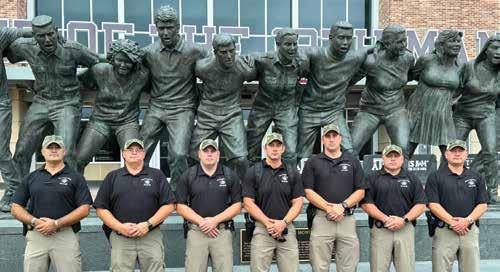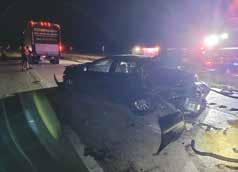
4 minute read
How Do You Know You’ve Been Exposed to Radiation?
By Cpl. Dustin Henderson, Radiation/Nuclear Detection Unit, Texas Department of Public Safety
When you hear the word “radioactive,” what comes to mind? Some think of the Incredible Hulk, Chernobyl or Three Mile Island. Others think of Kansas Highway Patrol Tpr. Nick Wright screaming "RADIOACTIVE!" in the highest pitch possible at the top of his lungs. Either way, it can be a scary term. Radiation is odorless, colorless, tasteless and doesn’t feel like anything. So, how do you know you’re being exposed to it?
The Texas Department of Public Safety (TXDPS) created its Radiation/Nuclear (Rad/ Nuc) Threat Detection Unit in February 2024 to locate radiation traveling along Texas roadways. Many other states have similar units, such as Florida, Colorado and Georgia. TXDPS has partnered with the City of Houston (Texas) through a Department of Homeland Security grant program called Securing the Cities (STC). The STC program aims to reduce the risk of successful radiological or nuclear terrorist attacks in major metropolitan areas by equipping and training state and local agencies to detect, analyze and report such materials.
TXDPS partnered with the City of Houston to secure funding to train and equip every TXDPS trooper with a personal radiation detector (PRD) through this grant program. The TXDPS Rad/ Nuc Unit comprises a lieutenant, a sergeant and six corporals. These individuals, with the assistance of field instructors and the City of Houston, have successfully trained and equipped approximately 800 troopers with PRDs across Texas since September 2024, focusing on the southern border first, and are scheduled to issue an additional 960 through the end of 2025. The rollout will continue through 2026.
How successful is the program? Since September 2024, TXDPS troopers have encountered radiological materials more than 170 times since being equipped with radiation detection equipment. These encounters range from medical patients to industrial use and contaminated fencing. Class 7 inspections have increased 62% compared to the year prior to creating the unit and equipping troopers across the state with PRDs.
The unit has deployed to numerous incidents across the state, including calls involving:
• A truck fire with a radiological source in which first responders believed they had ingested radiological material
• Suspicious package calls to ensure they were not dirty bombs
• Locating lost radioactive sources
• Crashes involving radioactive material
• High-attendance events such as the San Antonio Stock Show and Rodeo, Fiesta San Antonio, visits from dignitaries, college football games, the SpaceX Starship launch, and in 2026, the FIFA World Cup, with matches in Dallas and Houston
Many CMV inspectors do not realize you do not have to be CVSA Level VI certified to inspect most radioactive shipments. Most shipments do not require placards to be displayed. Many shipments consist of radiopharmaceuticals being transported to a hospital for medical purposes. Others are utilized in roadway construction, building construction, welding and the oilfield industry.
So, how do you know what vehicles are transporting radioactive materials? Detection capability is the key to locating radioactive materials because transport vehicles can range from a small passenger car or van to a trucktractor or semi-trailer. Even if you’re not Level VI certified, with the proper education and equipment, you can safely inspect radioactive materials that are not transuranic waste or highway route-controlled quantities. CVSA offers an excellent course through CVSA Learning (learning.cvsa.org) called “Class 7 Radioactive Material Inspections for the NonLevel VI Inspector.” The Counterterrorism Operations Support Center for Radiological Nuclear Training provides free training on the “luxurious beaches” of Mercury, Nevada, for first responders in interdicting and responding to radioactive incidents.
Want to learn more about what Texas is encountering and how we are responding?
Reach out to one of our TXDPS Rad/Nuc team members at radnuctriage@dps.texas.gov for information on securing training and equipment funding.






